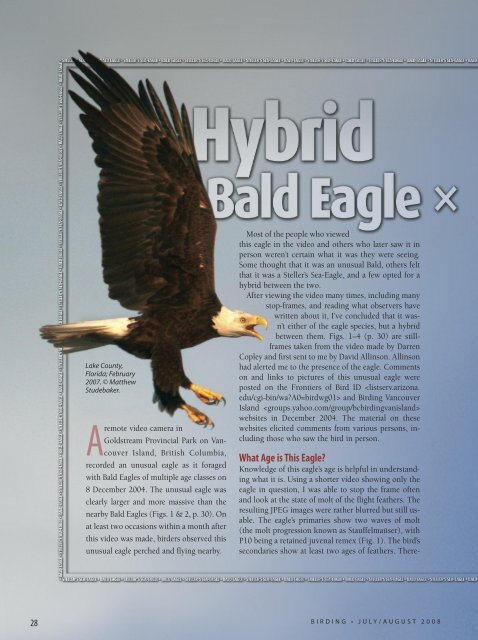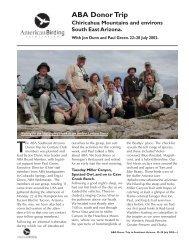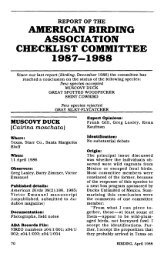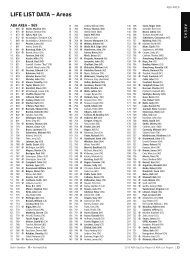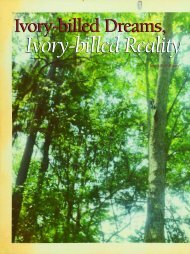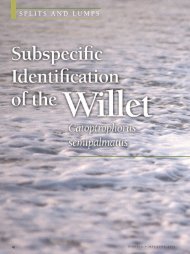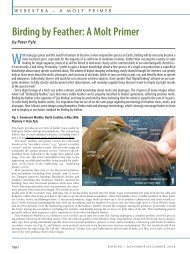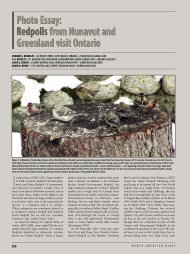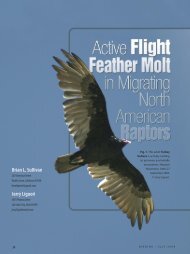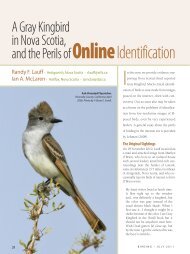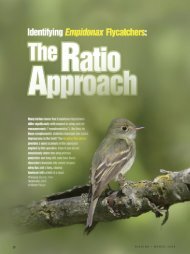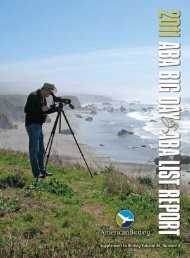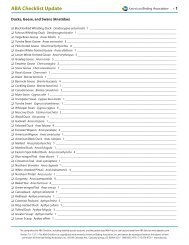What Age is This Eagle? - American Birding Association
What Age is This Eagle? - American Birding Association
What Age is This Eagle? - American Birding Association
You also want an ePaper? Increase the reach of your titles
YUMPU automatically turns print PDFs into web optimized ePapers that Google loves.
Lake County,<br />
Florida; February<br />
2007. © Matthew<br />
Studebaker.<br />
Aremote video camera in<br />
Goldstream Provincial Park on Vancouver<br />
Island, Brit<strong>is</strong>h Columbia,<br />
recorded an unusual eagle as it foraged<br />
with Bald <strong>Eagle</strong>s of multiple age classes on<br />
8 December 2004. The unusual eagle was<br />
clearly larger and more massive than the<br />
nearby Bald <strong>Eagle</strong>s (Figs. 1 & 2, p. 30). On<br />
at least two occasions within a month after<br />
th<strong>is</strong> video was made, birders observed th<strong>is</strong><br />
unusual eagle perched and flying nearby.<br />
Most of the people who viewed<br />
th<strong>is</strong> eagle in the video and others who later saw it in<br />
person weren’t certain what it was they were seeing.<br />
Some thought that it was an unusual Bald, others felt<br />
that it was a Steller’s Sea-<strong>Eagle</strong>, and a few opted for a<br />
hybrid between the two.<br />
After viewing the video many times, including many<br />
stop-frames, and reading what observers have<br />
written about it, I’ve concluded that it wasn’t<br />
either of the eagle species, but a hybrid<br />
between them. Figs. 1–4 (p. 30) are stillframes<br />
taken from the video made by Darren<br />
Copley and first sent to me by David Allinson. Allinson<br />
had alerted me to the presence of the eagle. Comments<br />
on and links to pictures of th<strong>is</strong> unusual eagle were<br />
posted on the Frontiers of Bird ID and <strong>Birding</strong> Vancouver<br />
Island <br />
websites in December 2004. The material on these<br />
websites elicited comments from various persons, including<br />
those who saw the bird in person.<br />
<strong>What</strong> <strong>Age</strong> <strong>is</strong> Th<strong>is</strong> <strong>Eagle</strong><br />
Knowledge of th<strong>is</strong> eagle’s age <strong>is</strong> helpful in understanding<br />
what it <strong>is</strong>. Using a shorter video showing only the<br />
eagle in question, I was able to stop the frame often<br />
and look at the state of molt of the flight feathers. The<br />
resulting JPEG images were rather blurred but still usable.<br />
The eagle’s primaries show two waves of molt<br />
(the molt progression known as Stauffelmaüser), with<br />
P10 being a retained juvenal remex (Fig. 1). The bird’s<br />
secondaries show at least two ages of feathers. There-<br />
28<br />
B i r d i n g • J u l y / A u g u s t 2 0 0 8
fore, th<strong>is</strong> eagle <strong>is</strong> in its third annual plumage (Clark 2004); th<strong>is</strong><br />
plumage <strong>is</strong> synonymous with the Basic III plumage of Howell et<br />
al. (2003). See Clark (2004) and Pyle (2005) for d<strong>is</strong>cussions of<br />
primary wave molt and its use in aging raptors.<br />
Why Not a Bald <strong>Eagle</strong><br />
Throughout the video, th<strong>is</strong> odd eagle, compared to the various<br />
Bald <strong>Eagle</strong>s next to it, shows a much larger and squarer head, a<br />
P.O. Box 531467<br />
Harlingen, Texas 78550<br />
raptours@earthlink.net<br />
larger and deeper beak, a<br />
more massive body, and<br />
much longer nape feathers<br />
(Figs. 2 & 3). Its upperparts<br />
are much like that of a juvenile Bald <strong>Eagle</strong>, but it has a<br />
larger, orangey beak (Figs. 1–4). It shows a pale circle around the<br />
eye, a character of some Steller’s Sea-<strong>Eagle</strong>s (see Fig. 3, p. 69 in:<br />
Morioka et al. 1995) but not of Bald <strong>Eagle</strong>s. In addition, its underparts<br />
are uniformly colored (Figs. 3 & 4); those of immature<br />
Bald <strong>Eagle</strong>s usually show the breast contrastingly darker<br />
than the belly (Clark and Wheeler 2001). The eagle’s<br />
uppertail <strong>is</strong> uniformly gray<br />
(Fig. 4), a trait shown only by<br />
some juvenile Bald <strong>Eagle</strong>s<br />
(Clark and Wheeler<br />
2001); all older<br />
Hokkaido,<br />
Japan; February<br />
1992. © William S.<br />
Clark / VIREO.<br />
the Bald <strong>Eagle</strong> (opposite page) <strong>is</strong> widespread and fairly common in Alaska and elsewhere in northwestern<br />
north America, and the Steller’s Sea-<strong>Eagle</strong> (th<strong>is</strong> page) <strong>is</strong> of casual occurrence in Alaska. At least one mixed<br />
pair <strong>is</strong> known from Alaska, and it <strong>is</strong> possible that there are others. th<strong>is</strong> article describes an immature eagle<br />
in Brit<strong>is</strong>h Columbia in late 2004 that appears to be a hybrid between Bald <strong>Eagle</strong> and steller’s sea-<strong>Eagle</strong>.<br />
w w w . A B A . o r g 29
H Y B R I D<br />
E A G L E<br />
Fig. 1 Fig. 2 Fig. 3 Fig. 4<br />
Fig. 1. Bald <strong>Eagle</strong> × Steller’s Sea-<strong>Eagle</strong> hybrid. note the molt of the primaries, with P6 and P7 paler than P8, P9,<br />
and P1–P5. Videograb. Gulfstream Park, Brit<strong>is</strong>h Columbia; 8 December 2004. © Darren Copley.<br />
Fig. 2. Bald <strong>Eagle</strong> × Steller’s Sea-<strong>Eagle</strong> hybrid. the hybrid has an orangey bill and <strong>is</strong> much larger overall than the<br />
juvenile Bald <strong>Eagle</strong> in the foreground. Videograb. Gulfstream Park, Brit<strong>is</strong>h Columbia; 8 December 2004. © Darren Copley.<br />
Fig. 3. Bald <strong>Eagle</strong> × Steller’s Sea-<strong>Eagle</strong> hybrid. not only <strong>is</strong> the hybrid larger in overall size than the juvenile Bald<br />
<strong>Eagle</strong> in the foreground, but it also has a relatively larger and squarer head. Videograb. Gulfstream Park, Brit<strong>is</strong>h<br />
Columbia; 8 December 2004. © Darren Copley.<br />
Fig. 4. Bald <strong>Eagle</strong> × Steller’s Sea-<strong>Eagle</strong> hybrid. note the gray upperside of the tail. Videograb. Gulfstream Park,<br />
Brit<strong>is</strong>h Columbia; 8 December 2004. © Darren Copley.<br />
Bald <strong>Eagle</strong>s have a white or pale gray uppertail, with a<br />
wide dusky subterminal band. Bald <strong>Eagle</strong>s in their<br />
third annual plumage show a white crown and cheeks,<br />
and usually white spots on the back forming a pale triangle<br />
(Fig. 5).<br />
Why Not a Steller’s Sea-<strong>Eagle</strong><br />
Steller’s Sea-<strong>Eagle</strong>s of all ages have deeply wedged<br />
white tails, with those of<br />
juveniles usually showing<br />
black tips (Wheeler and<br />
Clark 1995, Clark and<br />
Wheeler 2001; see also<br />
Fig. 3, p. 69 in: Morioka et<br />
al. 1995). Th<strong>is</strong> pattern <strong>is</strong><br />
shown by the Steller’s in<br />
its third annual plumage<br />
depicted in Fig. 6. The uppertail<br />
of the eagle in<br />
question was completely<br />
dark gray (Fig. 4), like<br />
that of some juvenile Bald<br />
<strong>Eagle</strong>s. As seen in the<br />
video and commented on<br />
Fig. 5. Basic III Bald <strong>Eagle</strong>.<br />
note the white crown and<br />
cheeks as well as the dusky<br />
beak. Boundary Bay, Brit<strong>is</strong>h<br />
Columbia; 6 February 2005.<br />
© William S. Clark.<br />
by people who saw th<strong>is</strong> eagle in flight, the tail wasn’t<br />
extremely wedge-shaped, like that of Steller’s (Fig. 6),<br />
but rather was somewhat wedge-shaped, although not<br />
strongly so (see Wheeler and Clark 1995, Clark and<br />
Wheeler 2001; see also Figs. 8 & 9, p. 72 in: Morioka<br />
et al. 1995).<br />
Steller’s Sea-<strong>Eagle</strong>s fly with their wings in a strong dihedral<br />
(Wheeler and Clark 1995, Clark and Wheeler<br />
2001). However, Allinson wrote<br />
on the <strong>Birding</strong> Vancouver Island<br />
website after seeing the eagle in<br />
flight, “I’m afraid th<strong>is</strong> bird has<br />
rather typical Baldie flat dihedral<br />
in flight. The tail, while more<br />
pointed than typical Baldies, <strong>is</strong><br />
still rounded when fanned out<br />
and nothing like what it should<br />
be for Steller’s.”<br />
Why a Hybrid Between<br />
These Two Species<br />
The eagle in question has characters<br />
of both species and, as d<strong>is</strong>cussed<br />
in the previous paragraphs,<br />
apparently <strong>is</strong>n’t either.<br />
For example, it doesn’t show the<br />
small crest of feathers on the forehead<br />
shown by some perched<br />
Steller’s (Figs. 1–6 & 17 in:<br />
Morioka et al. 1995). Moreover, it<br />
30<br />
B i r d i n g • J u l y / A u g u s t 2 0 0 8
has a uniformly gray upper tail, a trait never shown on<br />
Steller’s Sea-<strong>Eagle</strong>. Additionally, it shows an orangey<br />
beak, a character never shown by immature Bald <strong>Eagle</strong>.<br />
No other eagle looks like th<strong>is</strong> one.<br />
Mixed Pair<br />
A mixed pair of adult Bald <strong>Eagle</strong> and Steller’s Sea-<strong>Eagle</strong><br />
close to Juneau in Tagu Inlet has been together for<br />
more than 10 years during the breeding season<br />
.<br />
Many birders during th<strong>is</strong> time have chartered a helicopter<br />
and flown to see the adult Steller’s. Recently, another<br />
adult has been seen repeatedly on the Nuskagak River<br />
near Dillingham in southwestern Alaska . It<br />
<strong>is</strong> certainly possible, given the remoteness and vastness<br />
of the Bald <strong>Eagle</strong>’s range in Alaska, that other such<br />
mixed pairs occur. An immature hybrid from such a<br />
mixed pair might be expected to travel to the coast and<br />
then south to Vancouver Island during the winter.<br />
There are no publ<strong>is</strong>hed records of hybridization<br />
within the genus Haliaeetus. However, there are many<br />
records of hybrid raptors within other genera, for example,<br />
in the genus Buteo (Clark and Witt 2006), in<br />
Milvus kites (Sylvén 1977), and in Aquila eagles (Helbig<br />
et al. 2005).<br />
Th<strong>is</strong> most unusual eagle shown in the video taken in<br />
December 2004 at Goldstream Provincial Park <strong>is</strong> evidently<br />
neither a Bald <strong>Eagle</strong> nor a Steller’s Sea-<strong>Eagle</strong>, but<br />
rather has characters of both species. It <strong>is</strong> almost certain<br />
from its shared characters that th<strong>is</strong> eagle <strong>is</strong> a juvenile<br />
hybrid between the two, perhaps from the mixed<br />
pair of adults at Tagu Inlet, Alaska.<br />
Acknowledgments<br />
I thank David Allinson for telling me about th<strong>is</strong> unusual<br />
eagle and David Copley for providing me copies<br />
of the CD with images of the bird. Todd Katzner and<br />
the National Aviary in Pittsburgh provided the photo of<br />
the Steller’s Sea-<strong>Eagle</strong>, and I. Szabo made constructive<br />
comments on previous drafts.<br />
Literature Cited<br />
Clark, w.s. 2004. wave molt of the primaries of Accipitrid raptors, and its<br />
Fig. 6. Basic III Steller’s Sea-<strong>Eagle</strong>. note the massive beak<br />
and white tail on th<strong>is</strong> captive individual. National Aviary,<br />
Pittsburgh, Pennsylvania; 17 May 2007. © Erin Estell.<br />
use in ageing, pp. 705–804 in: r.d. Chancellor and B.-u. Meyburgh,<br />
eds. Raptors Worldwide: Proceedings of the Vth World Conference on<br />
Birds of Prey, Budapest. world working group on Birds of Prey, Berlin.<br />
Clark, w.s., and B.K. wheeler. 2001. A Field Guide to Hawks of North America.<br />
Houghton Mifflin, Boston.<br />
Clark, w.s., and C.C. witt. 2006. First known specimen of a hybrid Buteo:<br />
swainson’s Hawk (Buteo swainsoni) × rough-legged Hawk (B. lagopus).<br />
Wilson Journal of Ornithology 118:42–52.<br />
Helbig, A.J., i. seibold, A. Kocum, d. liebers, J. irwin, u. Bergman<strong>is</strong>, B.u.<br />
Meyburg, w. scheller, M. stubbe, and s. Bensch. 2005. genetic differentiation<br />
and hybridization between greater and lesser spotted <strong>Eagle</strong>s<br />
(Accipitriformes: Aquila clanga, A. pomarina). Journal of Ornithology<br />
146:226–234.<br />
Howell, s.n.g., C. Corbin, P. Pyle, and d.i. rogers. 2003 the first basic<br />
problem: A review of molt and plumage homologies. Condor<br />
105:635–653.<br />
Morioka, t., n. yamagata, t. Kouchi, and t. Kawata. 1995. The Birds of Prey<br />
of Japan. Bun-ichi sōgō shuppan, tokyo.<br />
Pyle, P. 2005. remigial molt patterns in north <strong>American</strong> Falconiformes as<br />
related to age, sex, breeding status, and life-h<strong>is</strong>tory strategies. Condor<br />
107:825–836.<br />
sylvén, M. 1977. Hybridization between red Kite Milvus milvus and Black<br />
Kite M. migrans in sweden in 1976. Vår Fågelvärld 36:38–44.<br />
wheeler, B.K., and w.s. Clark. 1995. A Photographic Guide to North <strong>American</strong><br />
Raptors. Princeton university Press, Princeton.<br />
w w w . A B A . o r g 31


